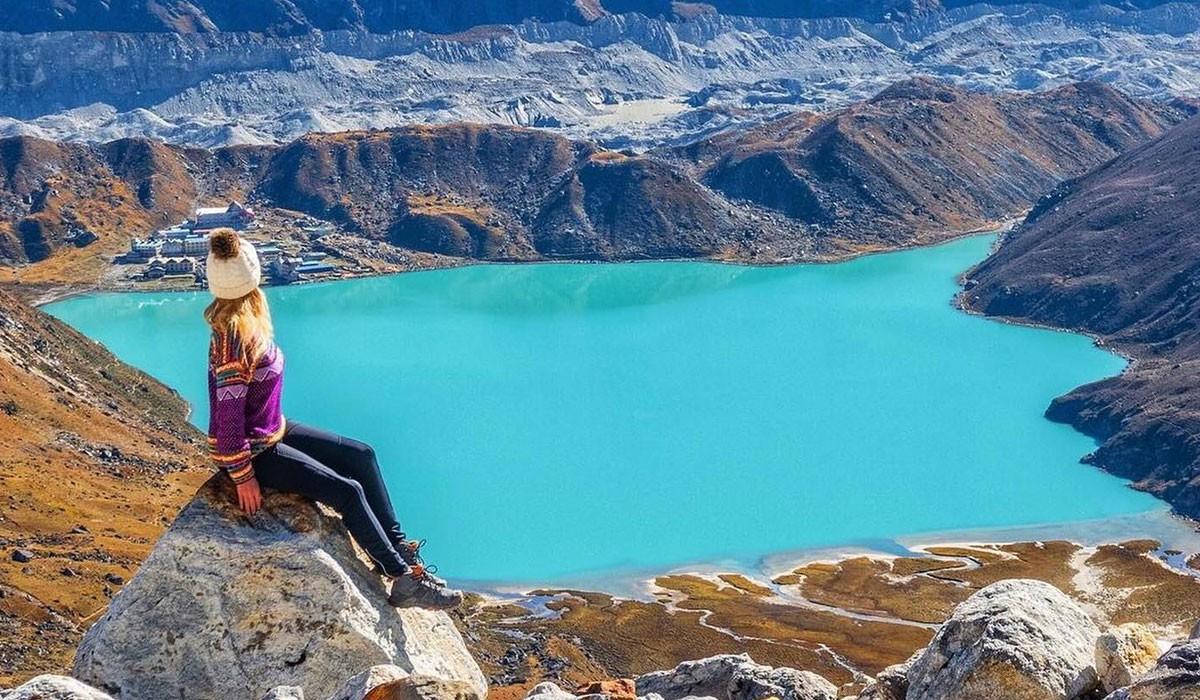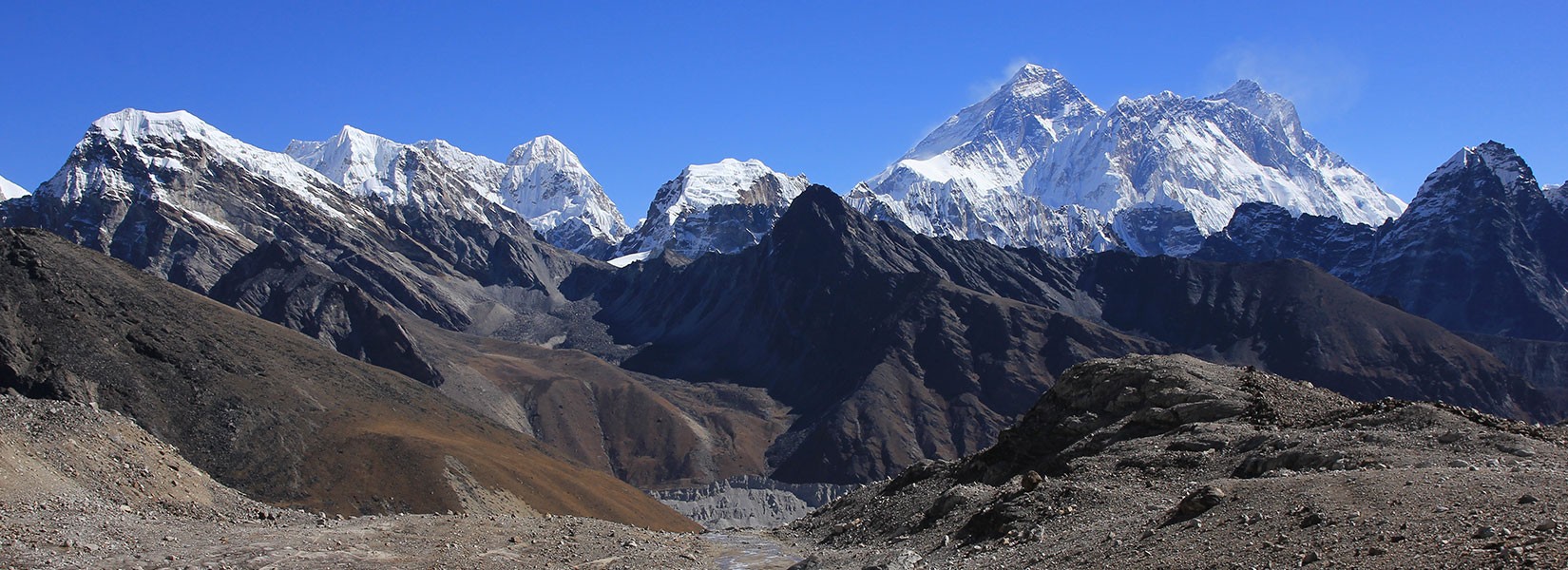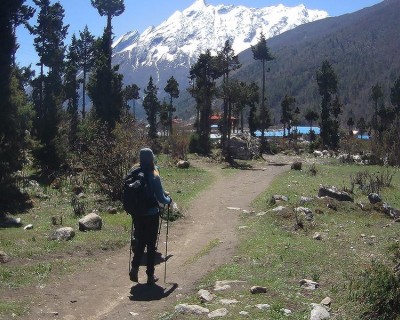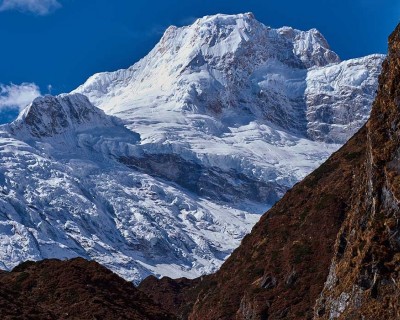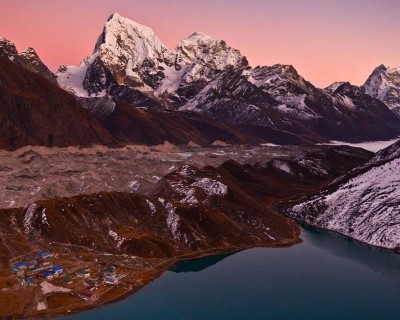Gokyo Valley Trek with Helicopter Return - Itinerary Plan
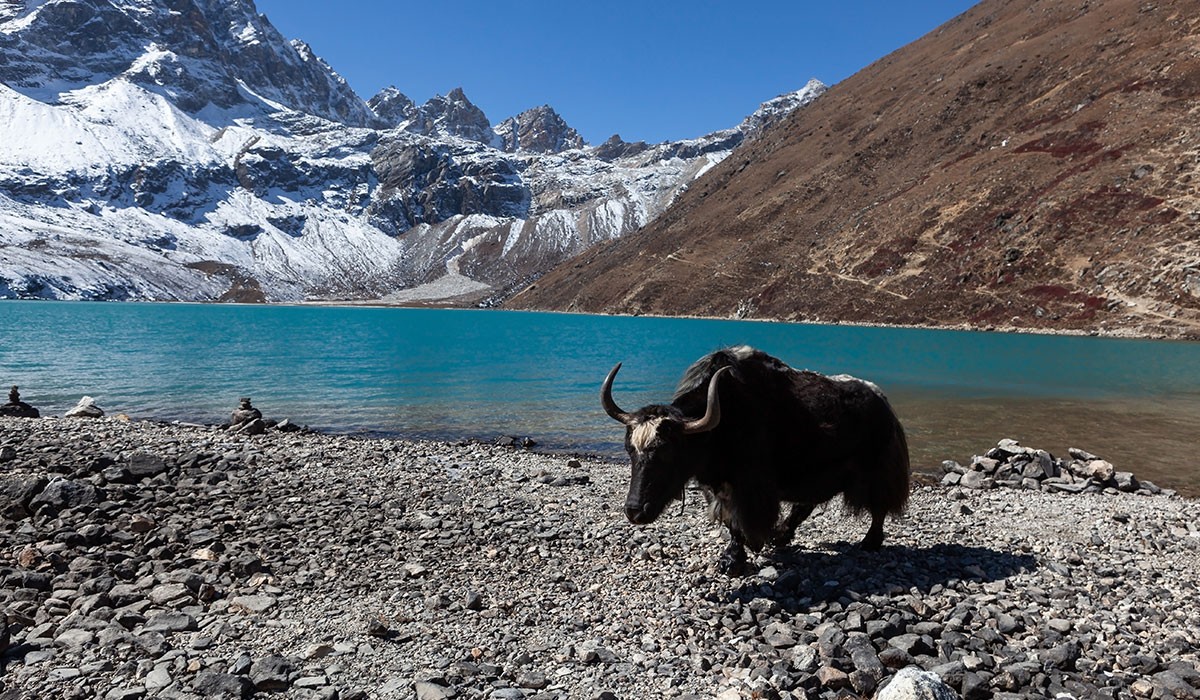
Day 01: Flight from Kathmandu to Lukla, then trek to Phakding
Kathmandu Altitude: 1,400 meters/ 4,593 feet
Lukla Altitude: 2,850 meters/ 9,350 feet
Phakding Altitude: 2,650 meters/ 8,694 feet
Altitude Gain: 1,450 meters/ 4,757 feet
You will join the exciting trekking trails of this mainstream route after a thrilling flight from Kathmandu to Lukla. Flying over the lush valleys and charming settlements, you will be able to enjoy the spectacular aerial views of the Himalayan vistas before making a touchdown at Lukla. After getting some rest, you will start trekking and make your descent to the banks of the Dudh Koshi River after crossing the Chauri Kharka Village.
Moving along the lush banks of the river, you will then trek past the Dudh Koshi Ghat (2,530 meters) to reach your first resting destination in Phakding. If you feel like it, you can also visit the Rimishung Monastery near the Sherpa village.
Flight Duration: 35 minutes
Trek Duration: 3 hours
Trek Distance: 6.2 km/ 3.8 miles
Day 02: Trekking from Phakding to Namche Bazaar
Phakding Altitude: 2,650 meters/ 8,694 feet
Namche Bazaar Altitude: 3,440 meters/ 11,286 feet
Altitude Gain: 790 meters/ 2,591 feet
This day’s trekking trail is filled with excitement; after breakfast, you will join the scenic banks of the Dudh Koshi River again and head toward Monjo Village across several suspension bridges. You will also trek past the villages of Tok Tok and Benkar on this day and enter the Sagarmatha National Park. Leaving the park, you will ascend on the Namche Ukalo to enter the vibrant Sherpa Capital. This day’s trek will reward you with the first glimpse of Mt. Everest.
Trek Duration: 6 hours
Trek Distance: 7.4 km/ 4.6 miles
Day 03: Acclimatization and hike around Namche
Namche Bazaar Altitude: 3,440 meters/ 11,286 feet
Before joining the trails of the Gokyo Lake that ascends higher from Namche, you will use this day to explore the charming Sherpa town and its popular highlights. Everest View Hotel, Khumjung Monastery, Hillary School, Syangboche Airstrip, Khunde Village, etc, are some of the popular hiking destinations around Namche that you can visit on this day.
Day 04: Trekking from Namche to Dole
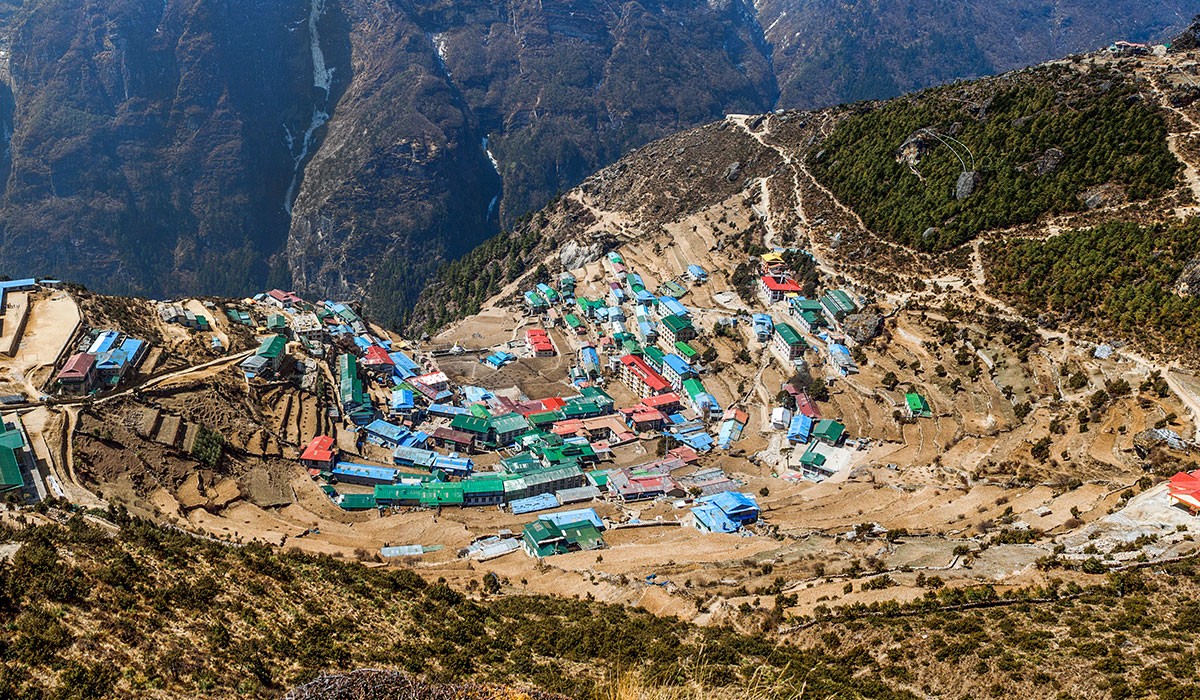
Namche Bazaar Altitude: 3,440 meters/ 11,286 feet
Dole Altitude: 4,200 meters/ 13,779 feet
Altitude Gain: 760 meters/ 2,493 feet
Leaving the mainstream trekking route of the Everest Base Camp Trek, on this day, you will trek inside the Gokyo Valley. Moving along the uphill and downhill sections along the route, you will make your descent to Mong La Pass (3,957 meters) and eventually reach the traditional village of Phortse Thenga.
You will continue trekking on the ascending route and trek past the yak pastures and small Sherpa settlements before reaching Dole.
Trek Duration: 5 hours
Trek Distance: 12 km/ 7.4 miles
Day 05: Dole to Machhermo
Dole Altitude: 4,200 meters/ 13,779 feet
Machhermo Altitude: 4,470 meters/ 14,665 feet
Altitude Gain: 270 meters/ 885 feet
From Dole, you will make your ascend on the exposed steep ridge and move along your exciting trekking trail, enjoying the epic views of Cho Oyu, Kantega, and Thamserku. Trekking across the serene grazing meadows, you will also pass the high-altitude traditional villages of Lhabarma and Luza before reaching Machhermo Village.
Trek Duration: 5-6 hours
Trek Distance: 7 km/ 4.3 miles
Day 06: Trekking from Machhermo to Gokyo Lake
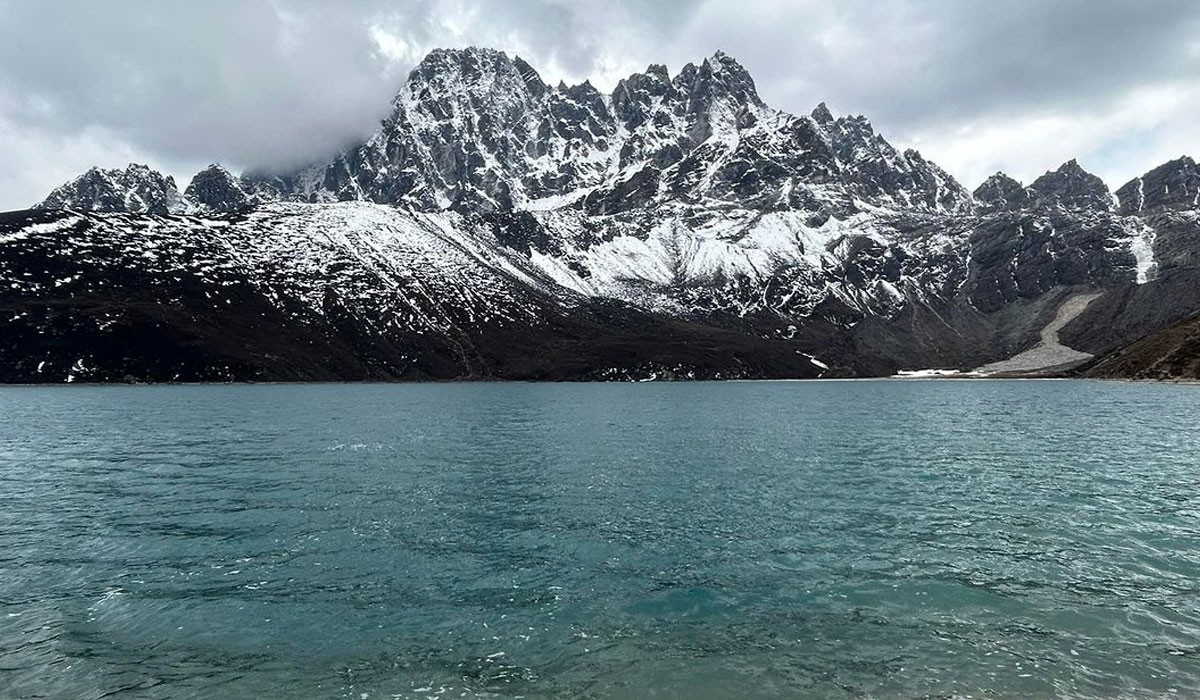
Machhermo Altitude: 4,470 meters/ 14,665 feet
Gokyo Lake Altitude: 4,790 meters/ 15,715 feet
Altitude Gain: 320 meters/ 1,049 feet
Leaving Macchermo behind, you will trek toward the main highlight of this Himalayan adventure. Trekking for about one hour, you will reach the Phanga Village; you will also cross the Nilibuk Village on this day. After crossing a bridge, you will arrive at the first lake, Longpongo Lake; you will then continue trekking on the moraine of the Ngozumpa Glacier, crossing the second lake and heading toward the main lake, Gokyo Lake.
Trek Duration: 4 hours
Trek Distance: 5.7 km/ 3.5 miles
Day 07: Morning hike to Gokyo-Ri and trek down to Gokyo for helicopter flight back to Kathmandu
Gokyo Lake Altitude: 4,790 meters/ 15,715 feet
Gokyo Ri Altitude: 5,357 meters/ 17,575 feet
Kathmandu Altitude: 1,400 meters/ 4,593 feet
Altitude Gain: 567 meters/ 1,860 feet
On this day, you will first hike to the Gokyo-Ri before dawn to enjoy the magical sunrise and the breathtaking panoramic views of the Himalayan peaks like Everest, Lhotse, Makalu, and Cho Oyu. After the hike, you will walk down to Gokyo Valley, from where you will take a charter flight back to Kathmandu.
Hike Duration: 2-3 hours
Hike Distance: 1.5 km/ 0.93 miles
What is the Best Time for the Gokyo Valley Trek with Helicopter Return?
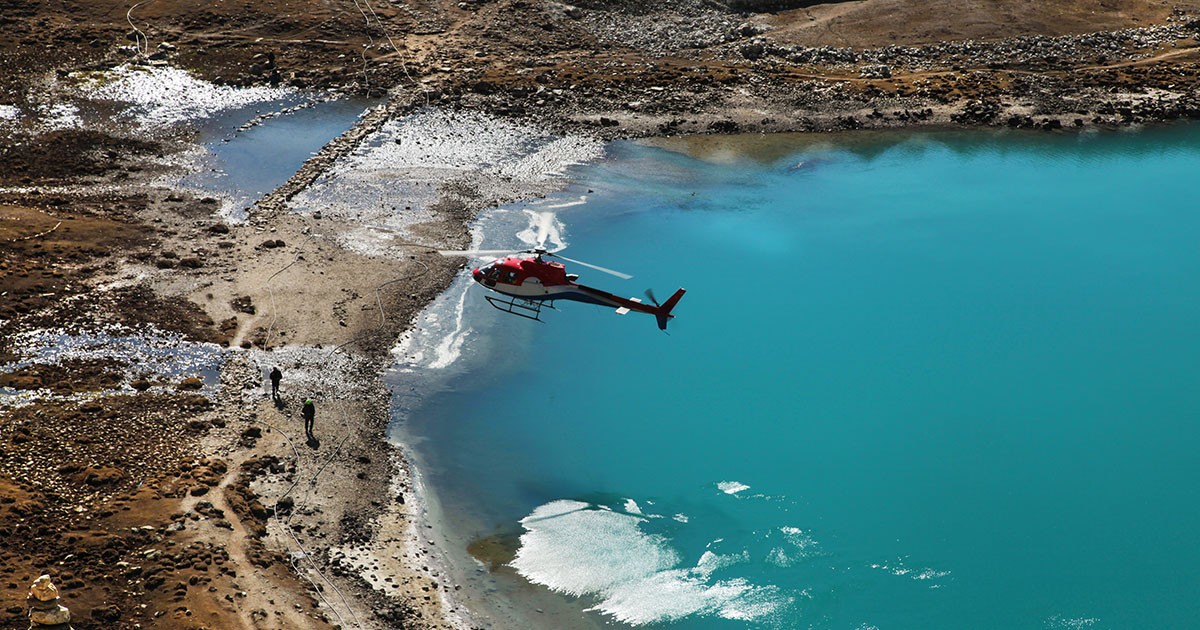
Gokyo Valley Trek with Helicopter Return is suitable during any season throughout the year, it depends on what kind of experience you are looking for. Although the high seasons, like spring (March to May) and autumn (Septemeber to November), are the most favored period through the year, the low seasons, like winter (December to February) and monsoon (June to August) do have their unique strong points. If you are looking forward to maximizing the experience, we will recommend you take on the Gokyo Lake Trek route during the high seasons.
Out of the two peak periods for the exploration of this second most popular highlight in the Everest region, the spring season has always been an undisputed winner for the most pleasant and memorable experience. During the spring season, the dotted rhododendron flower takes over the lower trails; similarly, the lush greenery and stunning visuals of nature’s peak point stretch as far as eyes can reach. Also, if you are a nature lover and want a proper insight into the rich biodiversity of the Sagarmatha National Park, you should explore this classical route at least once in the spring season.
Similarly, the autumn season, another high point for the Gokyo Lake Ri Trek, is mostly known for its stability. The climate during this is stable; the trekking route is well-maintained and stable, the temperatures are stable without any major spikes and the clear days reward you with the most stunning panoramic views of the Himalayas vistas. The autumn season is also the epicenter for the most major festivals in the country; if you time your trek right, you will have the opportunity to have a first-hand experience with some of the significant festivals in the country, like Dashain, Tihar, Chhath, Indra Jatra, Mani Rimdu, Pachali Bhairab Jatra, etc.
Temperatures of Gokyo Valley During Peak Seasons
Temperature of Gokyo Valley During Spring (March to May): 5°C to 22°C; max up to 25°C
Temperature of Gokyo Valley During Autumn (Septemeber to November): 4°C to 17°C
Trek Difficulty
The Gokyo Lake difficulty is at a moderate level; trekking enthusiasts who are eager to navigate this iconic route of the Everest region don’t need to have any previous trekking experience or any set of technical expertise. Even if this trek is suitable for beginners, there are several aspects of this high-altitude journey that you have to be mindful of.
The altitude gain itself can be a significant challenge for trekkers who don’t have any experience in high-altitude adventures. Your trekking adventure on the exciting route of the Gokyo Lakes Trek Nepal starts after landing at Lukla (2,850 meters). You will then move along the charming trails that take you across the high-altitude points of the region, reaching the maximum point at Gokyo Ri (5,357 meters). Thus, the overall altitude gain in his excursion to the highest freshwater lake system chain on the planet is about 2,507 meters (8,225 feet).
Thus, even if the altitude gain isn’t that significant if you are not careful about your body language and don’t acclimatize properly, suffering from Acute Mountain Sickness (AMS) can make the journey bothersome. The total trekking distance of the Gokyo Lake Trek route is about 92 km (57 miles); you will navigate the rugged mountain trails of the valley for about 5-6 hours on average during the trekking days. However, as you will return to Kathmandu via a chartered helicopter flight, you won’t have to do the return trek to Lukla. So this will cut the total trekking distance by about half, i.e., 46 km (28 miles); this means that the Gokyo Valley Trek Return by Helicopter is relatively easier than the regular Gokyo Lakes Trek Nepal.
How to Train for Gokyo Lakes Trek Nepal?
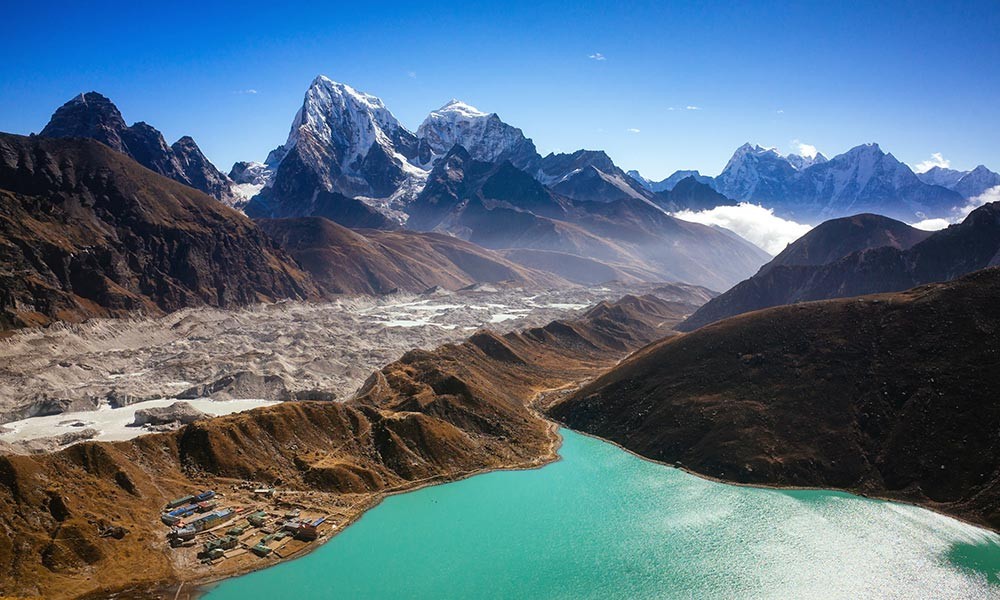
Before starting your training for the Gokyo Valley Trek Return by Helicopter, you need to first evaluate your physical capabilities and understand the actual demands of the trek. If you are physically active and exercise regularly, you will not need to prepare an elongated training program. However, if you rarely exercise and are not that physically active, your priority should be on getting your body accustomed to the physical activities. For a high altitude trekking in the Nepali Himalayas, you should at least start your preparations 3 to 8 weeks before the start of your adventure.
For the training, you should consider the overall trekking distance and the walking hours you have to put in carrying your luggage. Similarly, you will also traverse a diverse range of terrain in the Gokyo Lake Trek route: steep sections, loose soil, rocky and boulder-strewn trails as well as the slippery glacial moraines. You will also ascend to higher altitudes with each passing point, reaching the paramount point at Gokyo Ri (5,357 meters). Thus, you need to take these factors into account and create efficient training programs that will help you overcome the overall Gokyo Lake difficulty.
Strength and Endurance Training
Doing long hours of trek carrying your luggage is not an easy task. Thus, you need to work on your overall endurance level to make the journey comfortable or bearable, the only difference among these two is dedication. If you strive to make your journey comfortable, you will truly enjoy the experience and savor the magical moments rather than just dragging yourself from one point to another.
Strength and Endurance Training Exercises
- Lunge
- Plank
- Leg Raise
- Calf Raise
- Curl
- Squat
- Deadlift
- Push Up
- Pull Up
- Leg Press
- Leg Extension
- Step Up
Stamina and Cardiovascular Training
Stamina and cardiovascular training will enhance your overall stamina reserve and improve your body’s capabilities to handle a low-oxygen saturation environment. So, don’t forget to add these exercises to your training program if you want to experience a seamless acclimatization process.
Stamina and Cardiovascular Training Exercises
- Cycling
- Jodding
- Dancing
- Jumping Rope
- Swimming
- Dancing
- Kick Boxing
- Mountain Climber
- High Knees
- Rowing
- Aerobics
- Jumping Jack
You may also like:
What Kind of Food and Accommodation Facilities Can You Expect in Gokyo Valley Trek Return by Helicopter?
The Gokyo Valley Trek with Helicopter Return takes place in the Everest region, which is the major trekking destination in the country. As the home to the world’s highest peak, the Everest region attracts thousands of trekkers all over the world every year. Besides the main attraction of this eastern Himalayan region, Everest Base Camp Trek, the Gokyo Lake Ri Trek takes second place in popularity. Thus, you can expect a decent to luxurious level of facilities in this mainstream region.
During your Gokyo Valley Trek with Helicopter Return, you will spend 6 nights at the teahouses/lodges in the trekking route. If your trekking package also oversees all your itinerary plans during your stay in Nepal, you will also spend 2 to 3 nights in Kathmandu. The quality of your accommodation facility will depend on the nature of your package; if it is a standard package, you will rest at comfortable teahouses with 2 to 3 adjacent beds in a private room. The bathroom facilities also have similar arrangements; you will share them with your roommates.
Note: If you want a more personalized and luxurious mode of accommodation facilities during your Himalayan journey, you can switch to luxurious or custom-tailored packages.
Food and Water
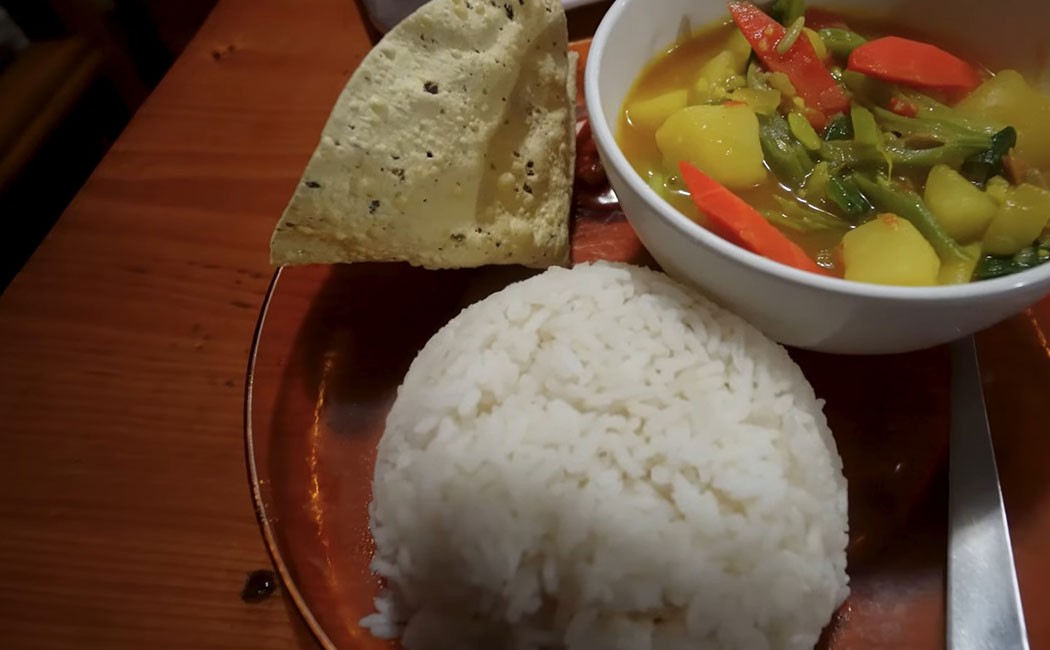
Like accommodation, the food prospects of this mainstream region are quite outstanding. You will have the opportunity to enjoy a diverse range of dishes that represent different cultures and are also a tongue-lingering blend of flavors. The menus available at teahouses of this region are mostly influenced by the Tibetan cultures; you will also be able to enjoy the traditional Hilly region dishes as well as Indian and Western menus.
Food Menu for Breakfast
- Tibetan Bread
- Toast
- Tea, Coffee, Milk
- Chapati
- Tsampa Porridge
- Tingmo
- Museli
- Buckwheat Bread
- Pancake
- Cornflake
- Honey, Butter, Jam
- Egg Items
- Oats
- Tingmo
- Kur
Food Menu for Lunch and Dinner
- Daal Bhat
- Dhindo Gundruk
- Momo
- Chowmin
- Thukpa
- Sherpa Stew
- Shyaphale
- Fried Rice
- Aloo Tama
- Chicken and Buff Steak
- Pizza
- Pasta
- Fries
Note: Both vegetarian and vegan options are available at the teahouses in this mainstream region. You can also request the chef to remove any ingredient from the meals you order.
Similarly, to keep the water level in your body to an optimum level, you are recommended to drink at least 2 to 3 liters of water during your trekking days. There are various sources in the Everest region to get safe and drinkable water; you can buy mineral water bottles at the teahouses, which can cost about US$ 2 to US$ 5, depending on the altitude. We don’t recommend this option as this is both costly and affects the environment.
Instead, you can use reusable bottles, and your guide will fill the bottles at the safe water station; you can then use the purification solutions to make the water safer. You can also buy boiled and filtered water along the trekking route; teahouses charge about US$ 2 per pot of water.
Packing Checklist
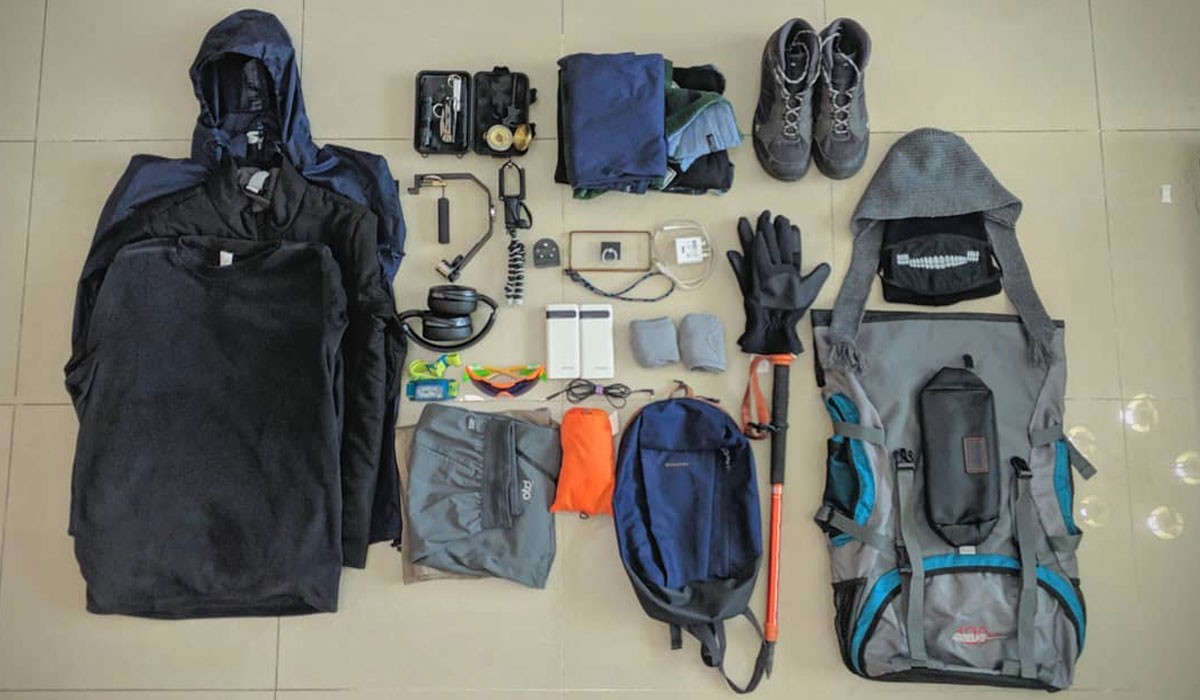
When embarking on an iconic journey, you need to make sure that you are prepared from every aspect to ensure a memorable experience. Your Gokyo Valley Trek with Helicopter Return takes you across diverse climatic zones and remote parts of the Himalayan region, so packing the right layers and helpful equipment will add pleasant flavors to your excursion. For your incredible Himalayan trekking adventure, Marvel Adventure will also provide helpful porters; the number of porters will depend on the group size.
Marvel Adventure will provide one porter for every two trekkers; the weight limit that the porter will carry is about 15kg per trekker. For carrying the extra luggage beyond the mentioned weight limit, you can either carry it by yourself or hire an extra porter for an additional cost. So, it will be best if you properly optimize your packing list not going overboard on the less essentials.
Packing for Head and Body
- Sport har or sun-brim hat
- Woolen hat or insulated warm hat
- Headscarf and neck scarf
- Moisture-wicking vest
- Warm thermals
- Lightweight t-shirts (full and half)
- Comfortable cotton shirt
- Breathable jacket
- Hooden rain cover jacket
- Waterproof/windproof outer layer
- Down jacket
- Lightweight gloves and insulated gloves
- Waterproof/windproof gloves
- Comfortable hiking shorts
- Lightweight cotton pant
- Breathable trousers
- Waterproof/windproof trousers
- Heavy woolen or insulated trousers
- Several pairs of undergarments
Packing For Feet
- Comfortable trekking boot
- Flexible sport or trainer shoes
- Breathable crocks or sandals
- Lightweight socks
- Insulated warm socks
- Waterproof gaiter
Personal Hygiene Items
- Toothbrush and toothpaste
- Bar soap and shampoo
- Sunscreen cream
- Body lotion and lip care
- Travel towel
- Small mirror
- Nail clipper and razor
- Deodorant
- Foot powder
- Insect repellent
- Sanitizer
- Tissue paper and wet wipes
- Toilet paper
- Earplug
- Eye mask
- Feminine hygiene products
- First aid kit
- Personal medications
Trekking Gear/Equipment
- UV Protection sunglasses
- Headlamp
- Trekking pole
- Sleeping bag
- Backpack and duffle bag
- Packing sack
- Water bottle and thermos flask
- Map and guidebook
- Camera
- Binoculars
- Small repair kit
- Powerbank
- Disposable bags
- Board games
- Books and journals
Note: Don’t forget to convert your currency into Nepali Rupees or acceptable currency during the trek; the available ATM services may not always be reliable.
Permits Gokyo Valley Trek Return by Helicopter
In this exciting Himalayan trekking excursion, you will traverse across a conserved national park as well as a restricted area in the Khumbu Valley. Thus, you will require only two permits to take part in this iconic journey.
Permits Required for the Trek
- Pasang Lhamu Rural Muncipality Permit
- Sagarmatha National Park Entry Permit
The Pasang Lhamu Rural Municipality Permit is a restricted area permit in the Khumbu Valley, and it costs around US$ 20 per trekker. Similarly, you will enter the Sagarmatha National Park from Monjo and will need a permit to enter; this national park permit costs about US$ 30 per person. Sagarmatha National Park Permit can be obtained from the tourism board office in the capital or at the entrance point in Monjo. As for the Pasang Lhamu Rural Municipality Permit, you will have to collect it from Lukla.
